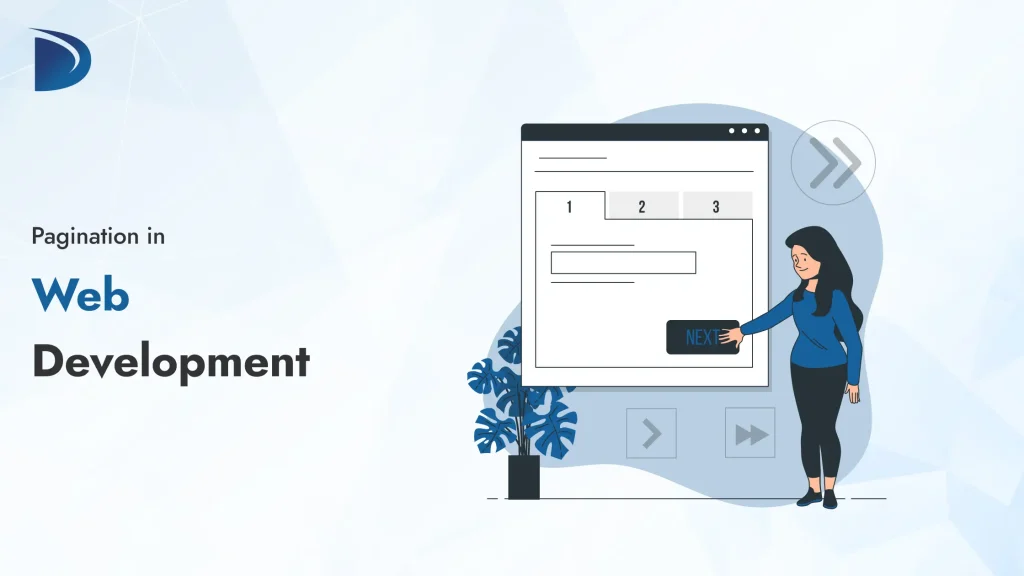Table of Contents
Pagination is a technique used in web development to break down large amounts of content into smaller, manageable pages. Instead of displaying all data at once, which can overwhelm users or slow down a website, pagination shows a limited number of items per page, making navigation smoother and content easier to digest. For instance, when you search for a product on an e-commerce site like Amazon or browse posts on a blog, you see a set number of results per page (e.g., 10 or 20 items), with options like “Next,” “Previous,” or page numbers to move through the content.
Pagination is essential for websites handling large datasets, such as online stores, news websites, social media platforms, or search engines. By organising content into pages, it enhances user experience, improves website performance, and makes data more accessible. This article explains pagination in detail, including why it’s important, how it works, different styles, implementation methods, advanced techniques, and related concepts like lazy loading, infinite scroll, and caching.
Why is Pagination Important?
Pagination offers several benefits that make it a cornerstone of web development:
- Improved Performance: Loading a smaller subset of data (e.g., 10 items instead of 1,000) reduces server load and speeds up page rendering. This is critical for websites with heavy traffic or large databases.
- Enhanced User Experience: Users can focus on a few items at a time, avoiding information overload. For example, seeing 10 products per page is less daunting than scrolling through 100.
- Easier Navigation: Pagination provides clear controls like page numbers or buttons, helping users find specific content quickly. This is especially helpful on mobile devices, where long pages are hard to navigate.
- Reduced Server Strain: By fetching only the data needed for one page, pagination lowers the demand on servers, making websites more scalable.
- SEO Advantages: Search engines like Google can crawl paginated pages more effectively when each page has a unique URL. Proper pagination setup (e.g., using canonical tags) prevents duplicate content issues, improving search rankings.
- Mobile Optimisation: Pagination ensures content is displayed in bite-sized chunks, which is ideal for smaller screens where scrolling through long lists can be tedious.
How Does Pagination Work?
Pagination involves splitting content into pages and providing a way for users to navigate between them.
Here’s a detailed look at how it works:
- Content Division: The total dataset (e.g., 500 blog posts, 1,000 products) is divided into smaller groups. For example, if you display 20 items per page, 500 items create 25 pages.
- Display Current Page: Only the items for the selected page are shown. For page 3 with 20 items per page, items 41–60 are displayed.
- Navigation Controls: Users interact with buttons or links, such as “Next,” “Previous,” or page numbers (1, 2, 3, etc.), to switch pages. These controls are usually placed at the top or bottom of the content.
- Backend Processing: The server retrieves only the data for the current page. For example, a database query might use LIMIT and OFFSET in SQL to fetch items 41–60 for page 3.
- Dynamic Updates: Modern websites use JavaScript to update content without reloading the entire page, creating a smoother experience. For example, clicking “Next” might trigger an AJAX call to fetch the next page’s data.
Types of Pagination
Pagination comes in various styles, each suited to different use cases:
- Numbered Pagination: Displays clickable page numbers (e.g., 1, 2, 3, …, 10). Users can jump to any page directly. This is common in search engines or product listings.
- Next/Previous Pagination: Offers simple “Next” and “Previous” buttons for sequential navigation. It’s ideal for linear content, like reading articles in a series.
- Load More Button: Instead of page numbers, a “Load More” button appends the next set of content to the current page. This is user-friendly for casual browsing, like on social media feeds.
- Infinite Scroll: While not traditional pagination, infinite scroll loads more content automatically as the user scrolls down, as seen on platforms like Instagram or Pinterest. It creates a seamless experience, but can make it harder to find specific items.
- Range-Based Pagination: Shows a range of page numbers (e.g., 1–5, 6–10) with arrows to move between ranges. This is useful for very large datasets to avoid cluttering the interface with too many page numbers.
Implementing Pagination in Web Development
Pagination requires coordination between the front end (user interface) and back end (data processing). Below is a detailed guide to implementing pagination.
1. Frontend Implementation
The front end handles the visual and interactive aspects of pagination:
- HTML/CSS: Create a navigation bar with page numbers or buttons.
Here’s a simple example:
HTML
<div class="pagination">
<a href="?page=previous">Previous</a>
<a href="?page=1">1</a>
<a href="?page=2">2</a>
<a href="?page=3">3</a>
<a href="?page=next">Next</a>
</div>CSS ensures the buttons are styled for clarity and responsiveness, with hover effects and mobile-friendly sizes.
- JavaScript: For dynamic pagination, JavaScript (or frameworks like React, Vue, or Angular) fetches new data without reloading the page. For example, an AJAX call might request data for page 2 and update the DOM:
javascript
fetch('/api/products?page=2&limit=10')
.then(response => response.json())
.then(data => updateContent(data));- Frameworks: Libraries like react-paginate or vue-paginate simplify pagination in modern frameworks, providing pre-built components for navigation.
2. Backend Implementation
The back end retrieves the correct subset of data:
- Database Queries: Use SQL to limit results. For example, to fetch items 21–30 for page 3 (10 items per page):
sql
SELECT * FROM products LIMIT 10 OFFSET 20;The LIMIT specifies how many items to return, and OFFSET skips the previous items.
- Server-Side Logic: Languages like Python (Django/Flask), PHP (Laravel), or Node.js calculate which items to send based on the page number. For example, in Python with Django:
python
from django.core.paginator import Paginator
products = Product.objects.all()
paginator = Paginator(products, 10) # 10 items per page
page_data = paginator.get_page(page_number)- Metadata: The backend often sends metadata, like the total number of items or pages, to help the frontend display accurate navigation controls.
3. API Integration
For modern web apps, APIs handle pagination. An API request might look like:
json
GET /api/products?page=3&limit=10
The server responds with the requested items and metadata:
json
{
"data": [...], // 10 products
"totalItems": 100,
"totalPages": 10,
"currentPage": 3
}Example of Pagination in Action
Imagine an online bookstore with 1,000 books. The developer sets pagination to show 20 books per page, creating 50 pages. When a user visits the site, they see the first 20 books and a navigation bar with “1, 2, 3, …, 50” or “Next.” Clicking “3” loads books 41–60. The backend query ensures only those 20 books are fetched, and JavaScript updates the page smoothly. The URL might change to ? page=3, helping users bookmark specific pages.
Advanced Pagination Techniques
Beyond basic pagination, developers can use advanced techniques to enhance functionality:
- Dynamic Page Size: Allow users to choose how many items to display per page (e.g., 10, 25, 50). This requires adjusting the LIMIT in queries and updating the frontend.
- Ellipsis Pagination: For large datasets, show only a few page numbers with ellipses (e.g., 1, 2, …, 10, …, 50) to avoid clutter. This balances usability and simplicity.
- Server-Side Caching: Store frequently accessed pages in memory (e.g., using Redis) to reduce database queries and speed up responses.
- Client-Side Caching: Cache page data in the browser to avoid repeated server requests when users revisit a page.
- Preloading: Load the next page’s data in the background while the user views the current page, reducing wait times when they click “Next.”
Related Concepts
To fully understand pagination, it’s helpful to explore related techniques that complement or replace it:
Lazy Loading
Lazy loading delays the loading of non-critical content, like images or videos, until they’re needed. For example, in a paginated photo gallery, images on page 2 aren’t loaded until the user navigates there. This saves bandwidth and speeds up initial page loads. Lazy loading is often implemented with JavaScript’s IntersectionObserver API:
javascript
const images = document.querySelectorAll('img[data-src]');
const observer = new IntersectionObserver((entries) => {
entries.forEach(entry => {
if (entry.isIntersecting) {
entry.target.src = entry.target.dataset.src;
}
});
});
images.forEach(img => observer.observe(img));Infinite Scroll
Infinite scroll loads more content as the user scrolls, like on Twitter or Pinterest. While seamless, it has drawbacks:
- Navigation Issues: Users can’t easily jump to a specific item or page.
- Performance Concerns: Loading too much content can slow the browser.
- SEO Challenges: Search engines may struggle to index dynamically loaded content.
Infinite scroll suits casual browsing, while pagination is better for structured data like search results.
Progressive Loading
Progressive loading combines pagination and infinite scroll. For example, a page might initially show 10 items, with a “Load More” button to append the next 10. This gives users control while maintaining a smooth experience.
Common Pitfalls and How to Avoid Them
Pagination isn’t without challenges. Here are common issues and solutions:
- Overloaded Navigation: Displaying too many page numbers (e.g., 1 to 100) can overwhelm users. Use ellipsis pagination or range-based navigation instead.
- Slow Queries: Large datasets can make database queries slow. Optimize with indexes, caching, or precomputed results.
- SEO Problems: Search engines may see paginated pages as duplicate content. Use rel=”next” and rel=”prev” in HTML or canonical tags to guide crawlers.
- Poor Mobile Experience: Small or hard-to-tap buttons frustrate mobile users. Use responsive design with large, touch-friendly controls.
- Accessibility Issues: Ensure pagination controls are navigable via keyboard and compatible with screen readers. Use ARIA attributes like aria-current=”page” for the active page.
Pagination in Modern Frameworks
Modern frameworks simplify pagination:
React: Use react-paginate for easy navigation components:
jsx
import ReactPaginate from 'react-paginate';
<ReactPaginate
pageCount={totalPages}
onPageChange={({ selected }) => setPage(selected + 1)}
/>
Vue: Use vue-paginate for similar functionality.
Django (Python): The Paginator class automates backend pagination:
python
paginator = Paginator(products, 10)
page_data = paginator.get_page(page_number)
Laravel (PHP): Laravel's pagination generates links and queries automatically:
php
$products = Product::paginate(10);Real-World Applications
Pagination is used across industries:
- E-commerce: Amazon and eBay use numbered pagination for product listings.
- Search Engines: Google uses pagination for search results, with page numbers and “Next.”
- Blogs: WordPress blogs paginate articles to keep pages lightweight.
- Social Media: LinkedIn uses “Load More” for job listings, combining pagination with progressive loading.
Best Practices for Pagination
To create effective pagination:
- Consistency: Use a fixed number of items per page (e.g., 10 or 20).
- Clear Navigation: Highlight the current page and make buttons easy to find.
- Context: Show “Page 3 of 50” or the total number of items.
- Performance: Optimize queries and use caching.
- Accessibility: Support keyboard navigation and screen readers.
- Mobile-Friendly: Ensure buttons are large and tappable on small screens.
Conclusion
Pagination is an essential feature of web development services that helps manage large datasets, improve performance, and enhance user experience. By dividing content into pages and providing intuitive navigation, pagination makes websites faster, more organized, and user-friendly. Advanced techniques like dynamic page sizes, caching, and preloading can further optimize pagination.
Understanding related concepts like lazy loading, infinite scroll, and progressive loading helps developers choose the best approach for their project. Whether building an e-commerce platform, blog, or search engine, mastering pagination ensures content is accessible and efficient for users worldwide.

